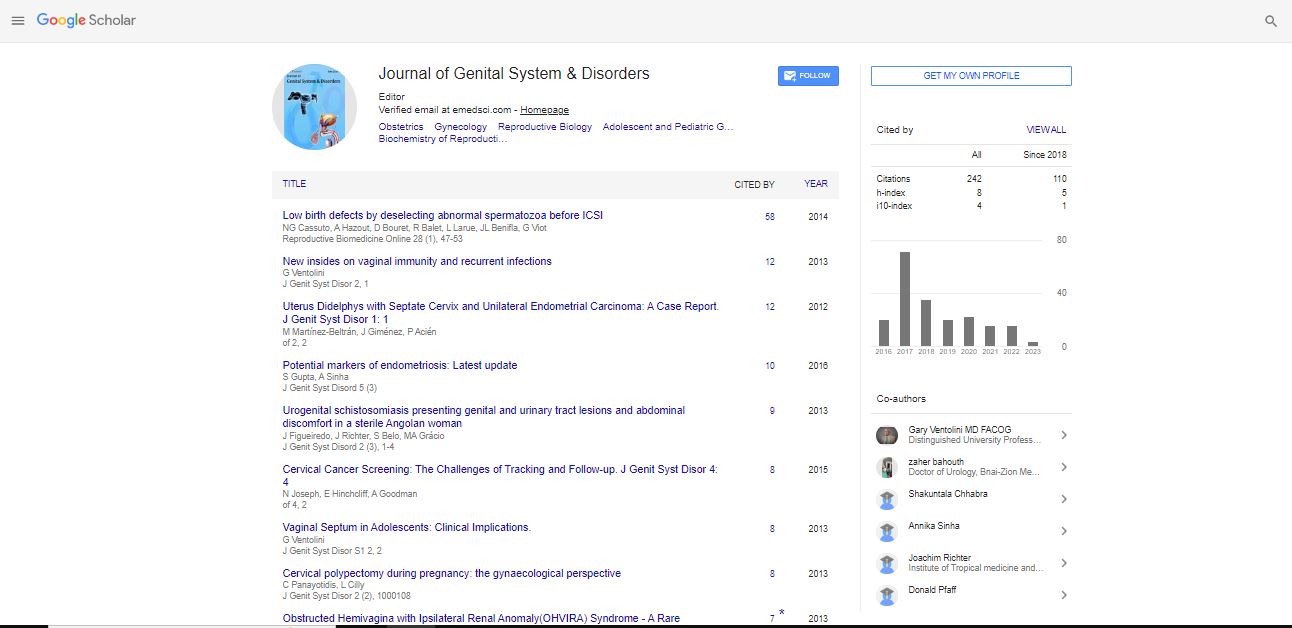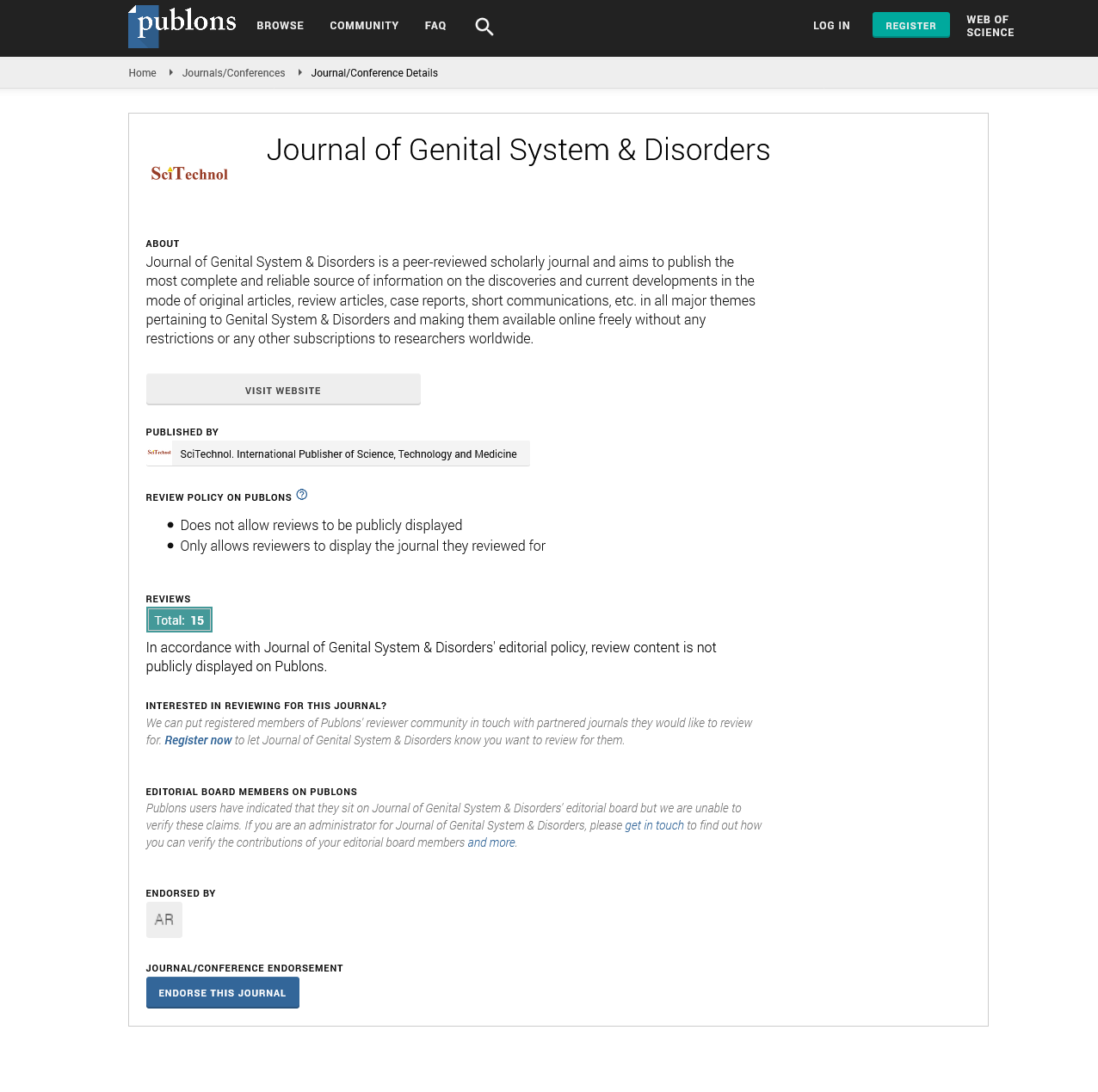Opinion Article, J Genit Syst Disord Vol: 12 Issue: 1
Molecular Mechanisms of Reproduction in Biochemistry of Reproductive Science
Karahmet Jabeen*
Department of Life Sciences, Monash University, Clayton, Australia
*Corresponding Author: Karahmet Jabeen
Karahmet Jabeen, Department of Life Sciences, Monash
University, Clayton, Australia;
E-mail: jabeenkarahmet@gmail.com
Received date: 22 February, 2023, Manuscript No. JGSD-23-96123;
Editor assigned date: 24 February, 2023, Pre QC No. JGSD-23-96123 (PQ);
Reviewed date: 10 March, 2023, QC No. JGSD-23-96123;
Revised date: 17 March, 2023, Manuscript No. JGSD-23-96123 (R);
Published date: 24 March, 2023, DOI: 10.4172/ 2325-9728.1000273
Citation: Jabeen K (2023) Molecular Mechanisms of Reproduction: Biochemistry of Reproductive Science. J Genit Syst Disord 12:1
Description
Reproduction is a fundamental biological process that ensures the continuation of life. The biochemistry of reproductive science involves the study of the molecular mechanisms that control reproductive processes, including gametogenesis, fertilization, implantation, and embryogenesis. Understanding the intricate biochemistry underlying reproduction is crucial for advancing the knowledge of reproductive biology and improving reproductive health outcomes.
Gametogenesis and Hormonal Regulation Gametogenesis, the process of forming gametes (sperm and eggs), is a complex and highly regulated process that involves intricate biochemical pathways and hormonal regulation.
Spermatogenesis: In males, spermatogenesis occurs in the testes and involves the production of sperm cells. It is regulated by various hormones, including Follicle-Stimulating Hormone (FSH), Luteinizing Hormone (LH), and testosterone. FSH stimulates the proliferation and maturation of spermatogonia, while LH stimulates the production of testosterone by Leydig cells, which is essential for sperm maturation and function.
Oogenesis: In females, oogenesis occurs in the ovaries and involves the production of mature eggs (oocytes). Oogenesis is a complex process that begins during fetal development and continues throughout a woman's reproductive years. It is regulated by various hormones, including FSH, LH, estrogen, and progesterone. FSH stimulates the growth and maturation of follicles, which contain the developing oocytes. LH triggers ovulation, the release of a mature egg from the ovary, and stimulates the production of estrogen and progesterone by the ovaries.
Hormonal regulation plays a critical role in gametogenesis, ensuring the proper development and maturation of sperm and eggs, and coordinating their release for fertilization.
Fertilization and early embryonic development
Fertilization is the process by which a sperm penetrates and fuses with an egg, resulting in the formation of a zygote, the first cell of a new individual. The biochemistry of fertilization involves a series of complex molecular events that ensure successful fusion of sperm and egg, as well as activation of the zygote for early embryonic development.
Sperm-Egg recognition and binding: Sperm and egg recognition and binding are mediated by specific proteins on their surfaces. Sperm undergo a process called capacitation, which involves the removal of inhibitory factors and changes in the sperm membrane that allow them to bind to the egg. The binding of sperm to the egg is facilitated by specialized proteins on the egg surface, such as zona pellucida glycoproteins, which interact with receptors on the sperm surface.
Acrosomal reaction: Upon binding to the egg, the sperm undergoes an acrosomal reaction, where enzymes stored in the acrosome (a structure at the tip of the sperm) are released. These enzymes help the sperm penetrate the protective layers of the egg, allowing the sperm to reach the egg's plasma membrane and fuse with it.
Cortical Reaction and zygote activation: Fusion of the sperm and egg triggers a series of biochemical events within the egg, known as the cortical reaction. The cortical reaction involves the release of calcium ions from the egg's cortical granules, which causes a hardening of the egg's zona pellucida, preventing polyspermy (fertilization by more than one sperm). The zygote is then activated for early embryonic development, initiating processes such as DNA replication, cell division, and gene expression.
Signaling pathways and epigenetic modifications: Various signaling pathways, including MAPK (mitogen-activated protein kinase), PI3K (phosphoinositide 3-kinase), and PLCγ (phospholipase Cγ), play crucial roles in fertilization and early embryonic development. These pathways are involved in regulating events such as sperm capacitation, egg activation, and embryonic cell division.
The biochemistry of reproductive science encompasses a wide range of molecular mechanisms and signaling pathways that govern gametogenesis, fertilization, implantation, and early embryonic development. Understanding the intricacies of these processes is essential for advancing our knowledge of reproductive biology and improving reproductive health outcomes, including the diagnosis and treatment of reproductive disorders and the development of ART. Further research in the biochemistry of reproductive science holds promise for advancing our understanding of reproductive biology and improving reproductive health outcomes for individuals and couples worldwide.
 Spanish
Spanish  Chinese
Chinese  Russian
Russian  German
German  French
French  Japanese
Japanese  Portuguese
Portuguese  Hindi
Hindi 
